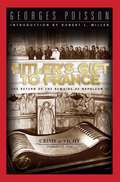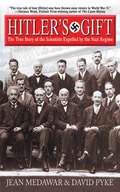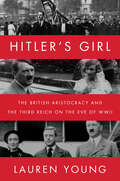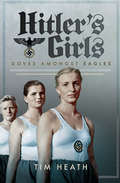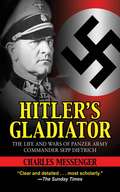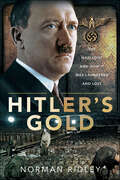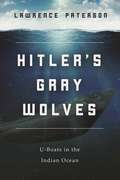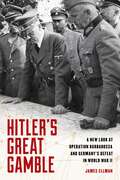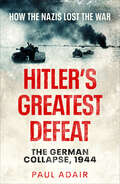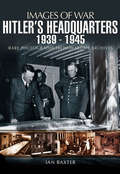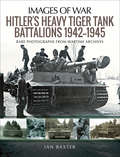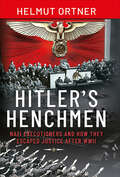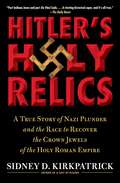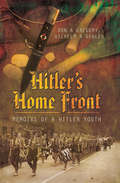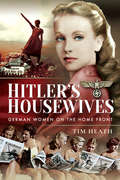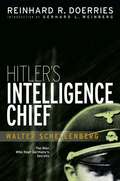- Table View
- List View
Hitler's Gift to France
by Robert Miller Georges PoissonIn the dead of the winter of 1940, Hitler decided to return from its burial place in Vienna the ashes of Napoleon II, known as the "Aiglon," the only son of the emperor Napoleon. The gesture was intended to win the support of the French people, but only managed to precipitate a political crisis at Vichy, where Marshal Pétain ordered the pro-German Deputy Prime Minister Pierre Laval arrested. Based on new research and previously unknown documents, the author, historian Georges Poisson, at last sheds light on an incident most historians--including Robert O. Paxton--have been at a loss to explain.
Hitler's Gift: The True Story of the Scientists Expelled by the Nazi Regime
by David Pyke Jean MedawarBetween 1901 and 1932, Germany won a third of all the Nobel Prizes for science. With Hitler's rise to power and the introduction of racial laws, starting with the exclusion of all Jews from state institutions, Jewish professors were forced to leave their jobs, which closed the door on Germany's fifty-year record of world supremacy in science. Of these more than 1,500 refugees, fifteen went on to win Nobel Prizes, several co-discovered penicillin--and more of them became the driving force behind the atomic bomb project.In this revelatory book, Jean Medawar and David Pyke tell countless gripping individual stories of emigration, rescue, and escape, including those of Albert Einstein, Fritz Haber, Leo Szilard, and many others. Much of this material was collected through interviews with more than twenty of the surviving refugee scholars, so as to document for history the steps taken after Hitler's policy was enacted. As one refugee scholar wrote, "Far from destroying the spirit of German scholarship, the Nazis had spread it all over the world. Only Germany was to be the loser."Hitler's Gift is the story of the men who were forced from their homeland and went on to revolutionize many of the scientific practices that we rely on today. Experience firsthand the stories of these geniuses, and learn not only how their deportation affected them, but how it bettered the world that we live in today.
Hitler's Girl: The British Aristocracy and the Third Reich on the Eve of WWII
by Lauren YoungA timely, riveting book that presents for the first time an alternative history of 1930s Britain, revealing how prominent fascist sympathizers nearly succeeded in overturning British democracy—using the past as a road map to navigate the complexities of today’s turn toward authoritarianism.Hitler’s Girl is a groundbreaking history that reveals how, in the 1930s, authoritarianism nearly took hold in Great Britain as it did in Italy and Germany. Drawing on recently declassified intelligence files, Lauren Young details the pervasiveness of Nazi sympathies among the British aristocracy, as significant factions of the upper class methodically pursued an actively pro-German agenda. She reveals how these aristocrats formed a murky Fifth Column to Nazi Germany, which depended on the complacence and complicity of the English to topple its proud and long-standing democratic tradition—and very nearly succeeded.As she highlights the parallels to our similarly treacherous time, Young exposes the involvement of secret organizations like the Right Club, which counted the Duke of Wellington among its influential members; the Cliveden Set, which ran a shadow foreign policy in support of Hitler; and the shocking four-year affair between socialite Unity Mitford and Adolf Hitler.Eye-opening and instructive, Hitler’s Girl re-evaluates 1930s England to help us understand our own vulnerabilities and poses urgent questions we must face to protect our freedom. At what point does complacency become complicity, posing real risk to the democratic norms that we take for granted? Will democracy again succeed—and will it require a similarly cataclysmic event like World War II to ensure its survival? Will we, in our own defining moment, stand up for democratic values—or will we succumb to political extremism?
Hitler's Girls: Doves Amongst Eagles
by Tim HeathThe &“frank, tragic, bittersweet, brutal, emotional&” true story of the Third Reich&’s so-called she-devils of the League of German Girls (Gerry Van Tonder, author of Berlin Blockade). They were ten to eighteen years old: German girls who volunteered for the war effort, and were indoctrinated into the Nazi youth organizations, Jungmädelbund and Bund Deutcscher Mädel. At first they were schooled in a very narrow education: how to cook, clean, excel at sports, birth babies, and raise them. But when Hitler called, they were trained, militarized, and exploited for the ultimate goal of the Third Reich. From the prosperous beginnings of the League of German Girls in 1933 to the cataclysmic defeat of 1945, Hitler&’s Girls is an insightful, disturbing, and revealing exploration of their specific roles: what was expected of them, and how they delivered, as defined by the Nazi state. Were they unwitting pawns or willing accessories to genocide? Historian Tim Heath searches for the answers and provides a definitive voice for this unique, and until now, unheard generation of German females. &“An essential account of the women who served Hitler during his years of power. Stunning photographs but a chilling narrative, in view of what they were required to do.&” —Books Monthly
Hitler's Gladiator: The Life and Wars of Panzer Army Commander Sepp Dietrich
by Charles MessengerA charismatic yet notorious character, Sepp Dietrich the man is impossible to separate from Sepp Dietrich the General, who was awarded twenty-four different honors during his service to the Nazi party and was known for his devotion to his men as he led them through some of the fiercest fighting in the war. In this extensively researched book, historian Charles Messenger attempts to discover the truth about this sparsely documented man, painting a vivid picture of the aggressive war and politics under the Third Reich. From Dietrich’s humble upbringing and his eventual rise to General, to his dissatisfaction with Hitler’s leadership and the trials he faced after the war, Dietrich remains a mysterious figure in history.
Hitler's Gold: The Nazi Loot and How it was Laundered and Lost
by Norman RidleyThe whereabouts and disposal of the Nazi's remaining stolen gold has led to numerous investigations and countless conspiracy theories. Norman Ridley uncovers many of the mysteries surrounding this continuing search for the missing millions. War is a costly business and in 1939, Germany was almost broke with its economy overheating and heading for runaway inflation. Hitler needed hard foreign currency to pay for his war machine and the only way he could get this was by selling gold that he looted from the national banks of Austria, Czechoslovakia and all the countries that were occupied after September 1939. Another source of gold was the theft of personal gold especially from the Jews, most grotesquely, the haul of dental gold which came out of the concentration camps. No neutral country would accept Reichsmarks so the gold had to be laundered through Swiss banks. The story of Swiss complicity in German war crimes is still a subject of controversy, and lawsuits. There are also questions about the parts played by other countries, particularly Portugal, in laundering stolen gold for the Nazis. The Vatican’s dealings with Hitler have often been seen as ambiguous and this book investigates the Holy See’s role in helping ship Nazi gold to South America, and how that gold might have been used to re-create the German Reich. After the war a commission was set up to recover as much gold as possible and restore it to those from whom it was stolen. This, of course, was beset by huge problems especially with regards to gold that was looted from Holocaust victims. Enormous quantities of gold and other treasures were hidden in a mine at Merkers in Thuringia which was found by the US 3rd Army in 1945, but much gold remains unaccounted for, and attempts are still ongoing to uncover supposed hidden caches, the most recent in Poland where four tons are believed to have been found by the Silesian Bridge Foundation in May of 2022. The whereabouts and disposal of the remaining stolen gold has led to numerous investigations and countless conspiracy theories. In Hitler’s Gold the author analyzes these and uncovers many of the mysteries surrounding this continuing search for the missing millions.
Hitler's Gray Wolves: U-Boats in the Indian Ocean
by Lawrence PatersonNext to nothing has been written about the U-boat war in the Indian Ocean. This is the story of a forgotten campaign. The battle began in August 1943, when a German submarine arrived in the Malaysian harbor of Georgetown. In total, nearly forty U-boats were assigned to penetrate the Indian Ocean, serving alongside troops of the occupying Imperial Japanese forces. The Japanese allowed U-boats to use Malaysia as an operational station. From that base, they mixed with Japanese forces on a hitherto unseen scale: a move which spread the U-boat war throughout the vast Indian Ocean and into the Pacific. Success in this theater of war held a real chance to swing the tide of battle in North Africa in favor of Rommel, but the Germans essentially did too little too late. The joint action also gave U-boats the opportunity to penetrate the Pacific Ocean for the first time, attacking shipping off the Australian coast and hunting off New Zealand. Plans were even afoot for an assault on American supply lines. The cooperation' also brought into stark relief the fundamental differences of German and Japanese war aims. After the crews of Italian supply submarines joined the Germans and Japanese, relations between the fighting men of the three main Axis powers were often brutal and almost constantly turbulent. Stories of U-boats laden with gold and treasure stem almost exclusively from boats destined to and returning from Japanese-controlled Malaysia, laden with material exchanged between the two major partners of the Triple Axis Alliance.
Hitler's Great Gamble: A New Look at German Strategy, Operation Barbarossa, and the Axis Defeat in World War II
by James EllmanOn June 22, 1941, Hitler invaded the Soviet Union in Operation Barbarossa, one of the turning points of World War II. Within six months, the invasion bogged down on the outskirts of Moscow, and the Eastern Front proved to be the decisive theater in the defeat of the Third Reich. Ever since, most historians have agreed that this was Hitler&’s gravest mistake. In Hitler&’s Great Gamble, James Ellman argues that while Barbarossa was a gamble and perverted by genocidal Nazi ideology, it was not doomed from the start. Rather it represented Hitler&’s best chance to achieve his war aims for Germany which were remarkably similar to those of the Kaiser&’s government in 1914. Other options, such as an invasion of England, or an offensive to seize the oil fields of the Middle East were considered and discarded as unlikely to lead to Axis victory.In Ellman&’s recounting, Barbarossa did not fail because of flaws in the Axis invasion strategy, the size of the USSR, or the brutal cold of the Russian winter. Instead, German defeat was due to errors of Nazi diplomacy. Hitler chose not to coordinate his plans with his most militarily powerful allies, Finland and Japan, and ensure the seizure of the ports of Murmansk and Vladivostok. Had he done so, Germany might well have succeeded in defeating the Soviet Union and, perhaps, winning World War II. Drawing on a wealth of primary and secondary sources (including many recently released), Hitler&’s Great Gamble is a provocative work that will appeal to a wide cross-section of World War II buffs, enthusiasts, and historians.
Hitler's Greatest Defeat: The German Collapse, 1944
by Paul AdairHow the Nazis lost the war1944 was a year of trial for the German Army. While the Allies were preparing to invade the Third Reich from the west, Stalin was set on a massive offensive to liberate the last remaining areas of Soviet territory still held by the Germans. Hitler was determined to hold fast. His muddled strategic thinking nullified the undoubted operational ability of his generals, and disaster was the inevitable result.This book is a gripping analysis of the Soviet campaign to capture Byelorussia, the German attempts to counter it, and the final, terrible collapse of Army Group Centre, inflicting even greater losses on the Germans than their earlier defeat at Stalingrad. It was a catastrophe of unbelievable proportions: 28 of 34 divisions, over 300,000 men, were lost. Hitler’s war effort was doomed and broken.An unputdownable history perfect for readers of Antony Beevor or James Holland.
Hitler's Grey Wolves: U-Boats in the Indian Ocean
by Lawrence PatersonVery little has been written about the U-boat war in the Indian Ocean, where almost forty German submarines were assigned to operate from the Malaysian port of Georgetown alongside troops of the occupying Imperial Japanese forces. From that base they sailed across the vast Indian Ocean and into the Pacific. Success in this theatre of war could very possibly have swung the tide of battle in North Africa in favour of Rommel, and the joint operations with the Japanese allowed the Germans to penetrate the Pacific Ocean for the first time, attacking shipping off the Australian coast and hunting off New Zealand. Plans were even made to attack US supply lines.Hitlers Grey Wolves is the story of this forgotten campaign, bringing it vividly to life through Lawrence Patersons incisive analysis, eyewitness testimony and an extensive collection of contemporary photographs.Very little has been written about the U-boat war in the Indian Ocean, where almost forty German submarines were assigned to operate from the Malaysian port of Georgetown alongside troops of the occupying Imperial Japanese forces. From that base they sailed across the vast Indian Ocean and into the Pacific.
Hitler's Gulf War: The Fight for Iraq 1941
by Barrie G. JamesThis military history of the Iraqi revolt in WWII, told from the point of view of the men who were there, is &“a fantastic and enjoyable book&” (Col. Tim Collins, OBE). In the spring of 1941, on an airfield fifty-five miles from Baghdad, a group of RAF airmen and soldiers were outnumbered by the better equipped Iraqi forces—soldiers who were aided by the Germans and Italians. After thirty days, this battle resulted in the first real defeat of the Axis powers in World War II. Hitler&’s Gulf War presents the story of the Iraqi revolt from the perspectives of the British, Iraqi, and Germans who were involved in the battle. Along with the group at the airfield, historian Barrie G. James examines the small relief column of cavalry, infantry, and Bedouins who traveled across a five-hundred-mile unmapped desert to support the RAF. With Germany&’s successes in Greece and the Western Desert in 1941, a British defeat here would have changed the course of World War II. Hitler&’s Gulf War traces how the battle destroyed Axis aspirations in the Middle East and also set the scene for Iraq&’s future relations with the West.
Hitler's Hangman: The Life of Heydrich
by Robert GerwarthA chilling biography of the head of Nazi Germany&’s terror apparatus, a key player in the Third Reich whose full story has never before been told. Reinhard Heydrich is widely recognized as one of the great iconic villains of the twentieth century, an appalling figure even within the context of the Nazi leadership. Chief of the Nazi Criminal Police, the SS Security Service, and the Gestapo, ruthless overlord of Nazi-occupied Bohemia and Moravia, and leading planner of the "Final Solution," Heydrich played a central role in Hitler's Germany. He shouldered a major share of responsibility for some of the worst Nazi atrocities, and up to his assassination in Prague in 1942, he was widely seen as one of the most dangerous men in Nazi Germany. Yet Heydrich has received remarkably modest attention in the extensive literature of the Third Reich. Robert Gerwarth weaves together little-known stories of Heydrich's private life with his deeds as head of the Nazi Reich Security Main Office. Fully exploring Heydrich's progression from a privileged middle-class youth to a rapacious mass murderer, Gerwarth sheds new light on the complexity of Heydrich's adult character, his motivations, the incremental steps that led to unimaginable atrocities, and the consequences of his murderous efforts toward re-creating the entire ethnic makeup of Europe. &“This admirable biography makes plausible what actually happened and makes human what we might prefer to dismiss as monstrous.&”—Timothy Snyder, Wall Street Journal &“[A] probing biography…. Gerwarth&’s fine study shows in chilling detail how genocide emerged from the practicalities of implementing a demented belief system.&”—Publishers Weekly &“A thoroughly documented, scholarly, and eminently readable account of this mass murderer.&”—The New Republic
Hitler's Hangmen: The Secret German Plot to Kill Churchill, December 1944
by Brian LettThis WWII history exposes a shocking episode of treason among the highest levels of British leadership in a conspiracy with Nazi High Command. At the outbreak of the Second World War, a number of Fascist groups were active in Britain, all plotting to overthrow the British government. When Winston Churchill became Prime Minister in 1940, he had the leaders of these groups arrested, including Member of Parliament Archibald Ramsey. When these men were released years later, they were just as determined to install a fascist government in Britain—and all the more embittered toward Churchill. In the autumn of 1944, Adolf Hitler&’s military gains were eroding across the map. In a desperate plan to avoid total defeat, he sought the simultaneous assassination of both Churchill and Eisenhower. This was the opportunity Ramsay and his cohorts had been waiting for. They planned a massive outbreak of British POW camps, the seizure of tanks and armored vehicles, and an advance on London. Ramsey himself would be perfectly placed to aid the coup—within yards of his greatest enemy, Winston Churchill, in the House of Commons. This is the incredible, disturbing story of how close British Fascists came to impacting the outcome of the Second World War. It is also a comprehensive investigation into the Break Out Plot as it unfolded across Britain: how it came to fruition and how it was quashed, its repercussions and the many little-known stories of escape and recapture which took place throughout the country.
Hitler's Hangmen: The Secret German Plot to Kill Churchill, December 1944
by Brian LettThis WWII history exposes a shocking episode of treason among the highest levels of British leadership in a conspiracy with Nazi High Command. At the outbreak of the Second World War, a number of Fascist groups were active in Britain, all plotting to overthrow the British government. When Winston Churchill became Prime Minister in 1940, he had the leaders of these groups arrested, including Member of Parliament Archibald Ramsey. When these men were released years later, they were just as determined to install a fascist government in Britain—and all the more embittered toward Churchill. In the autumn of 1944, Adolf Hitler&’s military gains were eroding across the map. In a desperate plan to avoid total defeat, he sought the simultaneous assassination of both Churchill and Eisenhower. This was the opportunity Ramsay and his cohorts had been waiting for. They planned a massive outbreak of British POW camps, the seizure of tanks and armored vehicles, and an advance on London. Ramsey himself would be perfectly placed to aid the coup—within yards of his greatest enemy, Winston Churchill, in the House of Commons. This is the incredible, disturbing story of how close British Fascists came to impacting the outcome of the Second World War. It is also a comprehensive investigation into the Break Out Plot as it unfolded across Britain: how it came to fruition and how it was quashed, its repercussions and the many little-known stories of escape and recapture which took place throughout the country.
Hitler's Headquarters, 1939–1945: Rare Photographs from Wartime Archives (Images of War)
by Ian BaxterAs well as being pathological about his security, Hitler believed only he could successfully oversee the Third Reichs operations. Thus he divided his time between his numerous HQs spread across his empire. We gain an insight into the atmosphere of fear and boredom, interspersed with outbursts of rage often against his generals that existed in these extraordinary installations. The book also reveals the extent of the engineering and building effort required to produce this chain of reinforced bunkers, which were constructed by huge labor forces of The Todt Organization. The book concludes with Hitlers final days in Chancellery bunker as the Russians advanced on Berlin.
Hitler's Heavy Tiger Tank Battalions, 1942–1945 (Images of War)
by Ian BaxterThe heavy tanks and other armored vehicles of WWII Germany come vividly to life in this informative volume of detailed wartime photos.With rare, often unpublished photographs and enlightening captions, Hitler’s Heavy Tiger Tank Battalions provides a superb record of the Wehrmacht’s Schwere Panzerableilung. In addition to the Tiger I and II heavy tanks, these battalions were equipped with Panzer III medium tanks; Flakpanzer IV self-propelled anti-aircraft guns, halftrack special purpose vehicles, Kettenkrad gun tractors, and Berge Panther armored recovery vehicles.Between 1942 and 1945, heavy tank battalions saw action on the Eastern Front, Italy and North West Europe before being pushed back to Berlin for the final defensive battles. This volume features graphic photographs and descriptions of vehicles on operations in all these theatres. Modelers and equipment buffs in particular will find this Images of War book extremely useful and fascinating.
Hitler's Henchmen: Nazi Executioners and How They Escaped Justice After WWII
by Helmut OrtnerHelmut Ortner reveals a staggering history of perpetrators, victims and bystanders in Hitler’s Germany. He explores the shocking evidence of a merciless era – and of the shameful omissions of post-war German justice. Johann Reichhart was a state-appointed judicial executioner in Bavaria from 1924 until the end of the war in Europe. During the Nazi era, he executed numerous people who were sentenced to death for resisting National Socialism, including many of those involved in the 20 July 1944 bomb plot on Adolf Hitler. As a member of the SS-Totenkopfverbände, the SS organisation responsible for administering the concentration and extermination camps, Arnold Strippel served at a number of locations during his rise to the rank of SS-Obersturmführer. These included Natzweiler-Struthof, Buchenwald, Majdanek, Ravensbrück and Neuengamme, where he was responsible for murdering the victims of a series of tuberculosis medical experiments. Like Reichhart, Erich Schwinge was also involved in the legal sphere during the Third Reich. A German military lawyer, in 1931 he became a professor of law and, from 1936, wrote the legal commentary on German military criminal law that was decisive during the Nazi era. Aside from the part they played in Hitler’s regime, these three men all had one further thing in common – they survived the war and restarted their careers in Adenauer’s Federal Republic of Germany. In Hitler’s Henchmen, Helmut Ortner uncovers the full stories of Reichhart, Strippel, Schwinge and others like them, Nazi perpetrators who enjoyed post-war careers as judges, university professors, doctors and politicians. Had they been gutless cogs in the machinery of the Nazi state, or ideologized persecutors? Ortner reveals that it was not only their Nazi pasts that were forgotten, but how the suffering of the victims, including resistance fighters such as Georg Elser and Maurice Becaud, and their relatives was suppressed and ignored.
Hitler's Holocaust
by Guido KnoppNo crime in the twentieth century has so deeply shocked mankind as the Holocaust. And none has so stubbornly resisted every attempt to explain it. More than six million people were murdered, and countless more endured horrific suffering. Guido Knopp's disturbing account is the most complete history of teh Holocaust to date. It reveals the appalling truth using the most recent historical research, including minutes of daily briefings by Joseph Goebbels, private papers of the SS Einsatzgruppen in charge of mass murder, and East German State Security documents detailing the deportation of Jews. The book relives the agony of the victims and investigations the motive of the perpetrators. Survivors talk for the first time about their horrifying torture and their eventual escape from Nazi persecution. The persecutors now at last confront the atrocities they committed. This is not an attempt to rewrite the history of the Holocaust, but a searing account of the greatest crime of the twentieth century - if not of all time - using the latest research on the subject.
Hitler's Holy Relics
by Sidney KirkpatrickFrom Paris to Stalingrad, the Nazis systematically plundered all manner of art and antiquities. But the first and most valuable treasures they looted were the Crown Jewels of the Holy Roman Empire. In Hitler's Holy Relics, bestselling author Sidney Kirkpatrick tells the riveting and never-before-told true story of how an American college professor turned Army sleuth recovered these cherished symbols of Hitler's Thousand-Year Reich before they could become a rallying point in the creation of a Fourth and equally unholy Reich.Anticipating the Allied invasion of Nazi Germany, Reichsführer Heinrich Himmler had ordered a top-secret bunker carved deep into the bedrock beneath Nürnberg castle. Inside the well-guarded chamber was a specially constructed vault that held the plundered treasures Hitler valued the most: the Spear of Destiny (reputed to have been used to pierce Christ's side while he was on the cross) and the Crown Jewels of the Holy Roman Empire, ancient artifacts steeped in medieval mysticism and coveted by world rulers from Charlemagne to Napoleon. But as Allied bombers rained devastation upon Nürnberg and the U.S. Seventh Army prepared to invade the city Hitler called "the soul of the Nazi Party," five of the most precious relics, all central to the coronation ceremony of a would-be Holy Roman Emperor, vanished from the vault. Who took them? And why? The mystery remained unsolved for months after the war's end, until the Supreme Allied Commander, General Dwight D. Eisenhower, ordered Lieutenant Walter Horn, a German-born art historian on leave from U.C. Berkeley, to hunt down the missing treasures.To accomplish his mission, Horn must revisit the now-rubble-strewn landscape of his youth and delve into the ancient legends and arcane mysticism surrounding the antiquities that Hitler had looted in his quest for world domination. Horn searches for clues in the burnt remains of Himmler's private castle and follows the trail of neo-Nazi "Teutonic Knights" charged with protecting a vast hidden fortune in plundered gold and other treasure. Along the way, Horn has to confront his own demons: how members of his family and former academic colleagues subverted scholarly research to help legitimize Hitler's theories of Aryan supremacy and the Master Race. What Horn discovers on his investigative odyssey is so explosive that his final report will remain secret for decades. Drawing on unpublished interrogation and intelligence reports, as well as on diaries, letters, journals, and interviews in the United States and Germany, Kirkpatrick tells this riveting and disturbing story with cinematic detail and reveals-- for the first time--how a failed Vienna art student, obsessed with the occult and dreams of his own grandeur, nearly succeeded in creating a Holy Reich rooted in a twisted reinvention of medieval and Church history.
Hitler's Home Front: Memoirs of a Hitler Youth
by Don A Gregory Wilhelm R GehlenA &“candid and revealing memoir shows a normal boy and a family at war and in its aftermath, determined to do what it took to survive . . . fascinating&” (The Great War). When Adolf Hitler and the Nazi Party came into power in 1933, he promised the downtrodden, demoralized, and economically broken people of Germany a new beginning and a strong future. Millions flocked to his message, including a corps of young people called the Hitlerjugend—the Hitler Youth. By 1942 Hitler had transformed Germany into a juggernaut of war that swept over Europe and threatened to conquer the world. It was in that year that a nine-year-old Wilhelm Reinhard Gehlen, took the &‘Jungvolk&’ oath, vowing to give his life for Hitler. This is the story of Wilhelm Gehlen&’s childhood in Nazi Germany during World War II and the awful circumstances which he and his friends and family had to endure during and following the war. Including a handful of recipes and descriptions of the strange and sometimes disgusting food that nevertheless kept people alive, this book sheds light on the truly awful conditions and the twisted, mistaken devotion held by members of the Hitler Youth—that it was their duty to do everything possible to save the Thousand Year Reich.
Hitler's Housewives: German Women on the Home Front
by Tim HeathThe roles and experiences of women in Nazi Germany, told in their own words for the first time.During Adolf Hitler’s 1932 election campaign, it is believed that over half those who voted for him were women. Germany’s women had witnessed the anarchy of the post-WWI years, and the chaos brought about by the rival political gangs brawling on their streets. When Hitler came to power there was at last a ray of hope that this man of the people would restore not only political stability to Germany but prosperity to its people.As reforms were set in place, Hitler encouraged women to step aside from their jobs and allow men to take their place. As the guardian of the home, the women of Hitler’s Germany were glorified as the very foundation for a future thousand-year Reich. Not every female in Nazi Germany, though, embraced the principle of living in a society where two distinct worlds existed—and with the outbreak of the Second World War, Germany’s women would soon find themselves on the frontline.Ultimately, Hitler’s housewives experienced mixed fortunes throughout the years of the Second World War. Some lost loved ones who went off to war never to return; some lost children to the influence of the Hitler Youth or to the Allied bombing; some sought comfort in the arms of other men; some would serve above and beyond the call of duty on the German home front. Their stories form intimate and intricately woven tales of life, love, joy, fear, and death. Hitler’s Housewives: German Women on the Home Front deepens our understanding of one of the twentieth century’s greatest tragedies, and the role played by Germany’s women on the home front, which ultimately became blurred within the horrors of total war. This is their story, in their own words, told for the first time.
Hitler's Intelligence Chief: Walter Schellenberg
by Gerhard L. Weinberg Reinhard R. DoerriesHitler's Intelligence Chief is a biographical portrait of SS General Walter Schellenberg during the final months of the Third Reich as he accompanied Heinrich Himmler while attempting to save his own life. Schellenberg was part of the Nazi leadership, although he never was directly involved in killing. In 1945, he negotiated the freeing of twenty thousand concentration camp inmates to Sweden through Count Bernadotte. He was arrested in Denmark and wrote his first memoir, which is reproduced in its entirety in this book, with notes and comments by Reinhard R. Doerries. At Nuremberg, Schellenberg was a witness and then served a six-year sentence. He died in Italy in 1952.
Hitler's Invasion of East Anglia, 1940: An Historical Cover Up?
by Martin W. BowmanThe aviation historian presents a provocative analysis of WWII airborne operations to investigate what happened to Hitler&’s planned invasion of England. Did a German invasion or invasions take place along the shores of East Anglia in 1940? Though Operation Sealion, the intended invasion of southern England, never materialized, Hitler asked his forces to mount one, two or even three small invasions in 1940. This raises some provocative questions: Were the mass raids on London merely a diversion? Why have all the files on this most dramatic period in British history been kept hidden? Why have the instances involving setting fire to the sea and skirmishes around our coasts been covered up? Martin W. Bowman tells the full story of these remarkable events involving British defenders in the Army, Home Guard and Auxiliary Units and the invading Nazi military forces. This revealing history examines Allied and German airborne operations during the Second World War to piece together a truly riveting narrative. It is complimented by an extensive Appendix section and scores of previously unpublished photos.
Hitler's Last Chance: Kolberg: The Propaganda Movie and the Rise and Fall of a German City
by Kevin PrengerThe war in Europe was reaching its cataclysmic final months with Germany surrounded on all sides. Hitler’s forces had been driven from Poland by the Red Army and the Soviets were poised a short distance from Berlin, while the Western allies, having repulsed the Führer’s Ardennes offensive, were preparing to cross the Rhine. More than ever, Hitler needed his people to stiffen their resolve for the coming onslaught. To demonstrate what will be expected of the German people, and what they could achieve if they refused to acknowledge defeat, a major feature film would be shown, featuring the one place which held out against Napoleon when he invaded Prussia in 1807 – the city of Kolberg. After crushing the Prussian Army in 1806, French forces swept into the Prussian province of Pomerania. One by one the Prussian fortresses surrendered, mostly without offering any resistance, except for Kolberg. The small and weakly-fortified city held out for four months despite being surrounded by Napoleon’s forces, with Major von Gneisenau organizing a citizen’s militia to aid the Army in its defense. Though much of the city was blasted into ruin, Kolberg remained in Prussian hands until the war with France ended with the signing of the Peace of Tilsit, by which time its defense had become legendary. Even though the Third Reich was literally entering its death-throes, in attempting to reproduce the siege of Kolberg on film, thousands of experts, extras and horses were taken from the war effort by the Reich Minister of Propaganda, Joseph Goebbels. The film’s emphasis was to show how civilians and the military can work together to save Germany – just as Kolberg had been saved from the French. The result has been stated to be the most expensive feature film ever made in Germany. This book examines the dramatic conditions under which the film was produced, and the scale of the resources needed to do so, followed by its first showing on 30 January 1945. All Goebbels' efforts, though, were to no avail, as the film never went on general release. A month later, as the author reveals, Kolberg found itself under siege once again, but this time, after bitter house-to-house fighting, it fell to the Soviets in less than four weeks.
Hitler's Last Chief of Foreign Intelligence: Allied Interrogations of Walter Schellenberg (Studies in Intelligence)
by Reinhard R. DoerriesWhen the curtains fell on the 'Thousand-Year Reich', in May 1945, SS-Brigadefuhrer Walter Schellenberg left for neutral Stockholm, only to be takn shortly thereafter to Frankfurt and London for interogating. The 'Final Report' on the Case of Walter Schellenberg is the revealing product of those Allied interogations. Reinhard R Doerries has written the first scholarly appraisal of Schellenberg as a Nazi leader and Hitler's final head of foreign intelligence.
